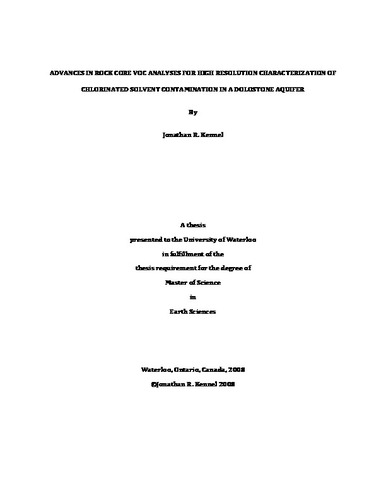| dc.description.abstract | The current understanding of contaminant migration in fractured sedimentary rock aquifers is inadequate due to the difficulty in describing the geologic and hydrogeologic controls on contaminant fate and transport with appropriate detail. To address contamination at fractured rock sites, multiple methods focusing on different aspects of the hydrologic system are required, and particular emphasis needs to be placed on the rock matrix. This thesis shows the further development and utility of the decade-old rock core VOC method (i.e. CORETM), a rock matrix method, when used in conjunction with multiple high resolution datasets as it applies to a 100 m thick highly productive dolostone aquifer in Guelph, Ontario.
The research site and surrounding area, located in the northwestern quadrant of the municipality of Guelph, was a productive zone for water supply until the early 1990s when the two closest municipal supply wells (Sacco, Smallfield) were shut down (1991, 1993 respectively) due to volatile organic compounds (VOCs) in the groundwater. Trichloroethene (TCE), a VOC, was used as a degreaser at the Guelph site and likely entered the groundwater more than 20 years ago. The thin overburden, shallow water table, relatively constant dolostone mineralogy, proximity to the UW analytical laboratory, relatively simple plume composition showing minimal degradation, and local importance make this an excellent study site for TCE fate and migration in fractured sedimentary rocks.
This thesis is composed of four chapters. Chapter 1 provides a brief background to the rock core VOC method and gives the conceptual framework for the investigation. Chapter 2 focuses on the further development of the rock core VOC method by providing the field validation of a recently adapted extraction method for VOCs in rock core using microwave assisted extraction (MAE), demonstrating the importance of rapid field preservation of samples, and comparing to the industry standard purge and trap method for VOCs on solid matrices. Results indicate that the microwave assisted extraction (MAE) method typically provides equivalent or higher concentrations when compared with the shake-flask and purge and trap extraction methods, indicating more complete extraction or less loss during transfer and/or storage. The purge and trap method provided false negatives (i.e. non-detects) due to inadequate preservation, incomplete extraction, and the elevated detection limit for TCE. The necessity for field preservation was examined by comparing crushed rock samples preserved in methanol in the field to samples unpreserved in the field with a laboratory addition of methanol less than 12 hours later. Chapter 3 creates high resolution porosity and bulk density logs by using selected geophysical logging tools in combination with core derived physical properties for the purpose of calculating porewater concentrations from total contaminant mass concentrations obtained from the rock core VOC method and sample specific rock properties relevant to the conversion. This is beneficial because total mass estimates obtained from the rock core VOC method are not necessarily indicative of the groundwater concentrations given the presence of solid organic carbon controlled sorption. Chapter 4 is a demonstration of the discrete fracture network approach (Parker 2007) applied to the Guelph field site with emphasis on the insights gained through high resolution contaminant profiles generated from cored holes in or near the source area and along a transect. Together, these four chapters present a framework for investigating VOC contamination in fractured sedimentary rocks and with emphasis on evaluating recent advances in the rock core VOC methodology in a field site context. | en |

